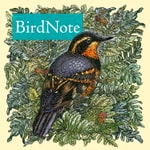BirdNote Daily – Details, episodes & analysis
Podcast details
Technical and general information from the podcast's RSS feed.

BirdNote Daily
BirdNote
Frequency: 1 episode/1d. Total Eps: 2451

Recent rankings
Latest chart positions across Apple Podcasts and Spotify rankings.
Apple Podcasts
🇨🇦 Canada - naturalSciences
02/08/2025#25🇬🇧 Great Britain - naturalSciences
02/08/2025#67🇩🇪 Germany - naturalSciences
02/08/2025#51🇺🇸 USA - naturalSciences
02/08/2025#7🇺🇸 USA - science
02/08/2025#54🇨🇦 Canada - naturalSciences
01/08/2025#18🇬🇧 Great Britain - naturalSciences
01/08/2025#54🇩🇪 Germany - naturalSciences
01/08/2025#39🇺🇸 USA - naturalSciences
01/08/2025#9🇺🇸 USA - science
01/08/2025#53
Spotify
No recent rankings available
Shared links between episodes and podcasts
Links found in episode descriptions and other podcasts that share them.
See allRSS feed quality and score
Technical evaluation of the podcast's RSS feed quality and structure.
See allScore global : 59%
Publication history
Monthly episode publishing history over the past years.
Does a Robin Hear Its Worm?
dimanche 1 septembre 2024 • Duration 01:45
How does a robin know a worm is in one exact spot? Does it see the worm or hear it? Smell it? Sense its movements through its feet? To find the answer, researchers buried worms in soil in a tray. They covered the soil with a thin but opaque sheet of cardboard, followed by more soil, so the robin couldn’t see the worms. Still, the robin found them with ease. The scientists concluded the birds are listening for their prey. There’s always more to learn about birds!
More info and transcript at BirdNote.org.
Want more BirdNote? Subscribe to our weekly newsletter. Sign up for BirdNote+ to get ad-free listening and other perks.
BirdNote is a nonprofit. Your tax-deductible gift makes these shows possible.
Catching Insects
samedi 31 août 2024 • Duration 01:45
Birds that depend on flies for food have many creative ways of catching their prey. Swallows execute sharp turns and quick changes of speed. Bluebirds watch from a perch, pouncing when the time is right. A Chuck-will’s-widow flies with its scoop-like mouth wide open, engulfing moths and other insects. A Merlin snares dragonflies in its talons. Hummingbirds dart into swarms of midges.
More info and transcript at BirdNote.org.
Want more BirdNote? Subscribe to our weekly newsletter. Sign up for BirdNote+ to get ad-free listening and other perks.
BirdNote is a nonprofit. Your tax-deductible gift makes these shows possible.
The Brown Thrasher's Never-Ending Songbook
jeudi 22 août 2024 • Duration 01:39
The Northern Mockingbird isn’t the only mimic bird in town. Brown Thrashers also learn songs from nearby birds and add them to their repertoire. The species has been documented singing over 1,100 different songs: a mix of imitations and invented little melodies. While mockingbirds usually repeat a song or phrase three or more times before moving on, Brown Thrashers tend to repeat a phrase only twice.
More info and transcript at BirdNote.org.
Want more BirdNote? Subscribe to our weekly newsletter. Sign up for BirdNote+ to get ad-free listening and other perks.
BirdNote is a nonprofit. Your tax-deductible gift makes these shows possible.
Saving Snags for Red-headed Woodpeckers
vendredi 24 mai 2024 • Duration 01:45
Red-headed Woodpeckers excavate cavities in large, dead trees called snags. Yet, over much of the Red-head's range, snags are frequently cut down as unsightly, or because they make good firewood. There are ways we can help the Red-headed Woodpecker -- and many other woodpeckers, too. The key is to leave snags intact. If you must cut down a tree on your property, consider leaving the lower trunk as a snag. It's like a wildlife condominium!
In the meantime, consider creating a nestbox for a woodpecker. Find a link to instructions here!
More info and transcript at BirdNote.org.
Want more BirdNote? Subscribe to our weekly newsletter. Sign up for BirdNote+ to get ad-free listening and other perks.
BirdNote is a nonprofit. Your tax-deductible gift makes these shows possible.
The Wonderchicken!
jeudi 9 décembre 2021 • Duration 04:45
In 2018, paleontologist Daniel Field took a closer look at specimens from an amateur fossil collector. His team used micro-CT scanning, kind of like a high-energy CAT scan, to visualize the encased fossils. They were amazed to find a tiny bird skull: the earliest known fossil record of a modern bird. The skull looks chicken-like in the front and duck-like in the back. The bird may have looked and behaved like a modern shorebird. Learn more at BirdNote.org.
Morning in Oaxaca
mercredi 8 décembre 2021 • Duration 01:45
A winter morning in Oaxaca, Mexico—a great time to visit old friends who spent the summer in the United States. Yellow-rumped Warblers and Western Tanagers—northern summer-nesters that winter in western Mexico—mingle with resident Berylline Hummingbirds, Gray Silky-Flycatchers, and this Crescent-chested Warbler.
Purchasing shade-grown coffee can help our neotropical migrants. Learn more at BirdNote.org.
Why Penguin Feathers Don't Freeze
mardi 7 décembre 2021 • Duration 01:39
Gentoo Penguins live in the frigid waters of the Atlantic. Only recently have scientists begun to unravel why penguin feathers don’t freeze. An electron microscope revealed tiny pores on the feathers that trap air, making the surface water repellent. This feature, plus a special coating oil from the preen gland, prevents water build-up and delays freezing. Engineers could attempt to apply these principles to prevent icing on plane wings. Learn more at BirdNote.org.
Birds on a Cold Night
lundi 6 décembre 2021 • Duration 01:45
During December, birds spend the long, cold nights in a protected place, sheltered from rain and safe from nighttime predators. Small forest birds, such as nuthatches and creepers, may spend the night huddled together in tree cavities. Birds like this male Mallard fluff up their feathers for insulation, hunker down over their legs and feet, and turn their heads around to poke their beaks under their shoulder feathers. Learn more at BirdNote.org.
Recording the Araripe Manakin, With Gerrit Vyn
dimanche 5 décembre 2021 • Duration 01:41
Near the city of Crato in northeastern Brazil lives a critically endangered little bird — the Araripe Manakin. It’s a little larger than a sparrow, it’s beautiful, and it lives on the slopes of a very small area in the Araripe Plateau. And because the Araripe Manakin wasn’t discovered until the late 1990s, it’s relatively unstudied. Gerrit Vyn of the Cornell Lab of Ornithology is on a mission to capture a “clean” recording of the Araripe Manakin — one without human-generated noise in the background. Will he succeed? Learn more at BirdNote.org.
Searching for the Araripe Manakin, With Gerrit Vyn
samedi 4 décembre 2021 • Duration 01:45
Gerrit Vyn is a sound recordist for the Cornell Lab of Ornithology. He recently traveled to northeastern Brazil’s Araripe Plateau in search of the Araripe Manakin, a beautiful white bird with dark wing-tips and tail-feathers — and a deep red hood. The Araripe Manakin is critically endangered, in part because of its limited range. But, as Gerrit observes, human activity also threatens the bird’s survival. Learn more at BirdNote.org.









